Exploring Literacy for Refugee Students: Challenges and Strategies
VerifiedAdded on 2023/06/14
|6
|1840
|290
Literature Review
AI Summary
This literature review examines the literacy challenges faced by refugee students in primary school settings, focusing on the impact of disruptive schooling and traumatic experiences. It identifies key issues affecting student learning, such as differences in prior learning experiences and the need for culturally relevant education. The review emphasizes the importance of literacy as a tool for empowerment and highlights exemplary teaching practices, including the use of technology, shared reading experiences, and storytelling. It also discusses the Cummins model for relating text to students' lived experiences and the implications for educators in creating effective learning environments for refugee students, stressing the need for culturally sensitive and intellectually challenging content to foster literacy development and integration.
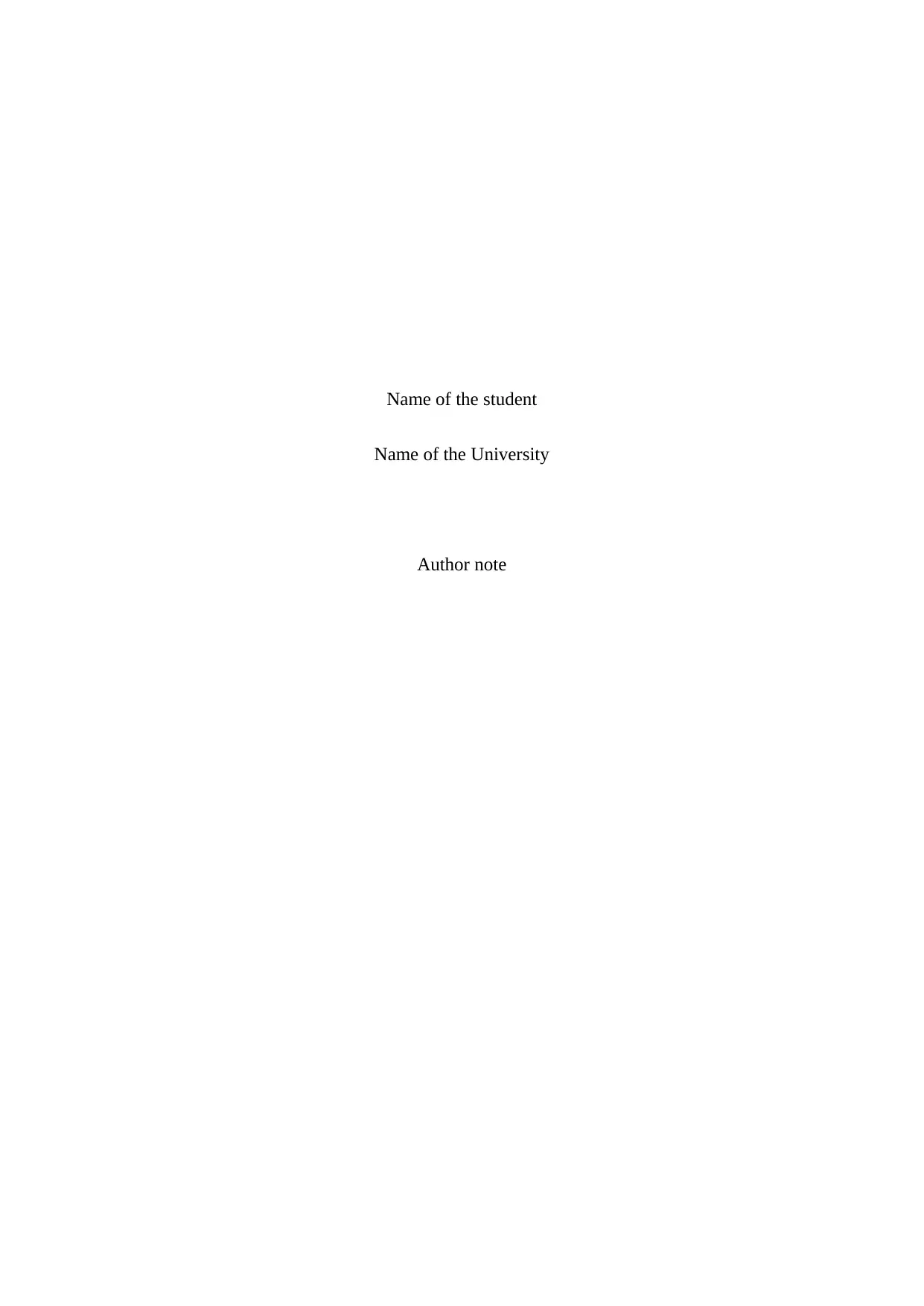
Name of the student
Name of the University
Author note
Name of the University
Author note
Paraphrase This Document
Need a fresh take? Get an instant paraphrase of this document with our AI Paraphraser
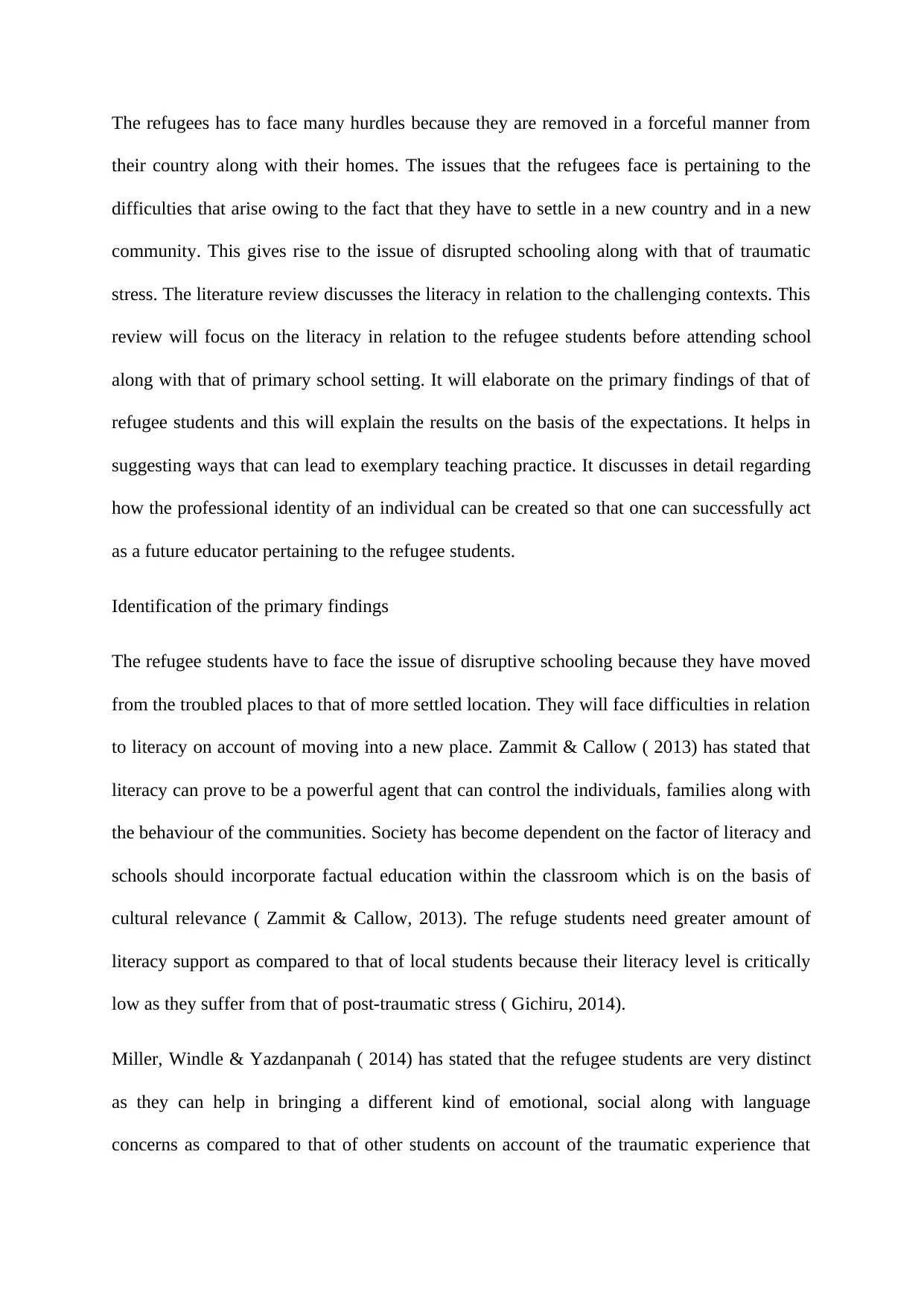
The refugees has to face many hurdles because they are removed in a forceful manner from
their country along with their homes. The issues that the refugees face is pertaining to the
difficulties that arise owing to the fact that they have to settle in a new country and in a new
community. This gives rise to the issue of disrupted schooling along with that of traumatic
stress. The literature review discusses the literacy in relation to the challenging contexts. This
review will focus on the literacy in relation to the refugee students before attending school
along with that of primary school setting. It will elaborate on the primary findings of that of
refugee students and this will explain the results on the basis of the expectations. It helps in
suggesting ways that can lead to exemplary teaching practice. It discusses in detail regarding
how the professional identity of an individual can be created so that one can successfully act
as a future educator pertaining to the refugee students.
Identification of the primary findings
The refugee students have to face the issue of disruptive schooling because they have moved
from the troubled places to that of more settled location. They will face difficulties in relation
to literacy on account of moving into a new place. Zammit & Callow ( 2013) has stated that
literacy can prove to be a powerful agent that can control the individuals, families along with
the behaviour of the communities. Society has become dependent on the factor of literacy and
schools should incorporate factual education within the classroom which is on the basis of
cultural relevance ( Zammit & Callow, 2013). The refuge students need greater amount of
literacy support as compared to that of local students because their literacy level is critically
low as they suffer from that of post-traumatic stress ( Gichiru, 2014).
Miller, Windle & Yazdanpanah ( 2014) has stated that the refugee students are very distinct
as they can help in bringing a different kind of emotional, social along with language
concerns as compared to that of other students on account of the traumatic experience that
their country along with their homes. The issues that the refugees face is pertaining to the
difficulties that arise owing to the fact that they have to settle in a new country and in a new
community. This gives rise to the issue of disrupted schooling along with that of traumatic
stress. The literature review discusses the literacy in relation to the challenging contexts. This
review will focus on the literacy in relation to the refugee students before attending school
along with that of primary school setting. It will elaborate on the primary findings of that of
refugee students and this will explain the results on the basis of the expectations. It helps in
suggesting ways that can lead to exemplary teaching practice. It discusses in detail regarding
how the professional identity of an individual can be created so that one can successfully act
as a future educator pertaining to the refugee students.
Identification of the primary findings
The refugee students have to face the issue of disruptive schooling because they have moved
from the troubled places to that of more settled location. They will face difficulties in relation
to literacy on account of moving into a new place. Zammit & Callow ( 2013) has stated that
literacy can prove to be a powerful agent that can control the individuals, families along with
the behaviour of the communities. Society has become dependent on the factor of literacy and
schools should incorporate factual education within the classroom which is on the basis of
cultural relevance ( Zammit & Callow, 2013). The refuge students need greater amount of
literacy support as compared to that of local students because their literacy level is critically
low as they suffer from that of post-traumatic stress ( Gichiru, 2014).
Miller, Windle & Yazdanpanah ( 2014) has stated that the refugee students are very distinct
as they can help in bringing a different kind of emotional, social along with language
concerns as compared to that of other students on account of the traumatic experience that
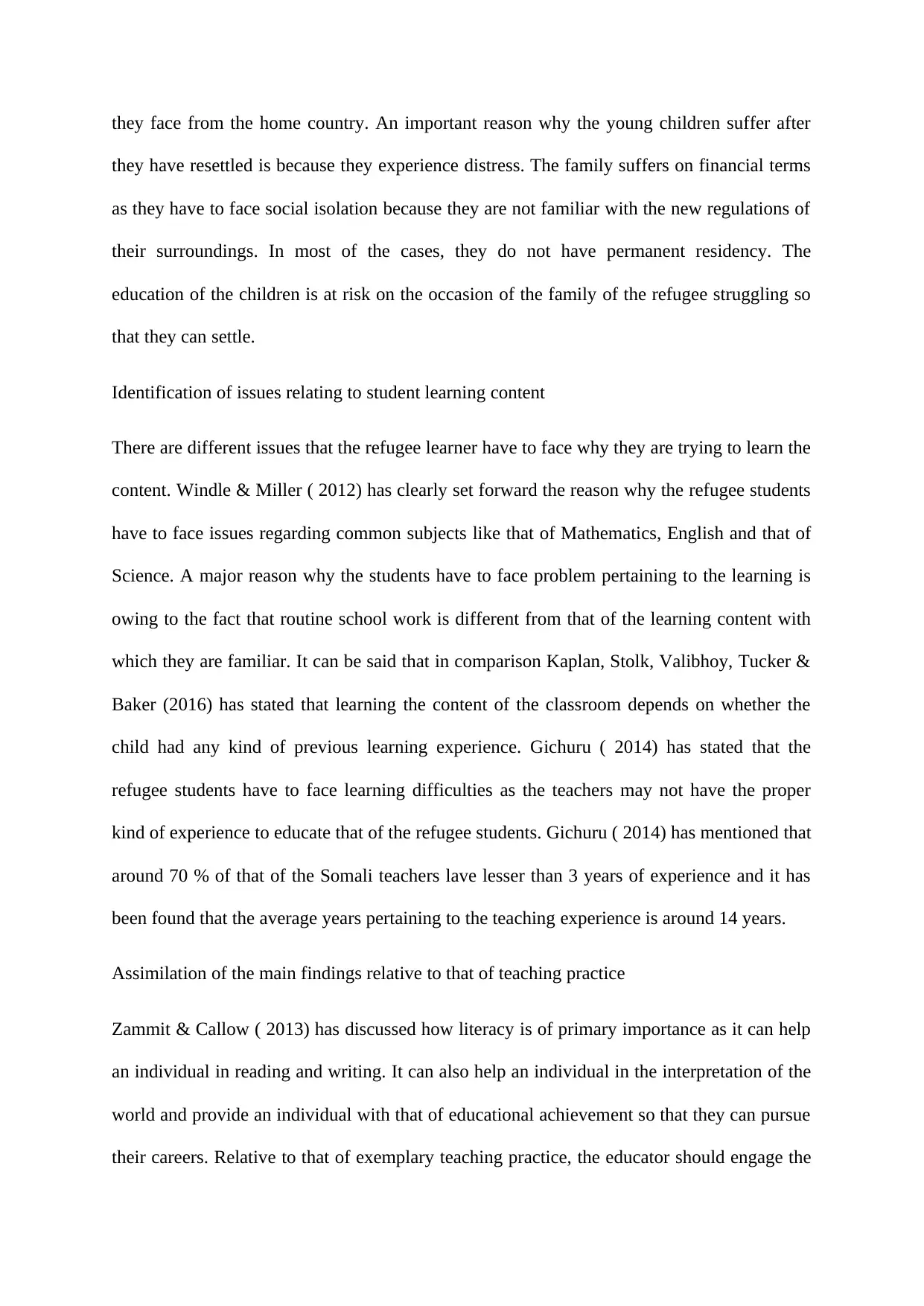
they face from the home country. An important reason why the young children suffer after
they have resettled is because they experience distress. The family suffers on financial terms
as they have to face social isolation because they are not familiar with the new regulations of
their surroundings. In most of the cases, they do not have permanent residency. The
education of the children is at risk on the occasion of the family of the refugee struggling so
that they can settle.
Identification of issues relating to student learning content
There are different issues that the refugee learner have to face why they are trying to learn the
content. Windle & Miller ( 2012) has clearly set forward the reason why the refugee students
have to face issues regarding common subjects like that of Mathematics, English and that of
Science. A major reason why the students have to face problem pertaining to the learning is
owing to the fact that routine school work is different from that of the learning content with
which they are familiar. It can be said that in comparison Kaplan, Stolk, Valibhoy, Tucker &
Baker (2016) has stated that learning the content of the classroom depends on whether the
child had any kind of previous learning experience. Gichuru ( 2014) has stated that the
refugee students have to face learning difficulties as the teachers may not have the proper
kind of experience to educate that of the refugee students. Gichuru ( 2014) has mentioned that
around 70 % of that of the Somali teachers lave lesser than 3 years of experience and it has
been found that the average years pertaining to the teaching experience is around 14 years.
Assimilation of the main findings relative to that of teaching practice
Zammit & Callow ( 2013) has discussed how literacy is of primary importance as it can help
an individual in reading and writing. It can also help an individual in the interpretation of the
world and provide an individual with that of educational achievement so that they can pursue
their careers. Relative to that of exemplary teaching practice, the educator should engage the
they have resettled is because they experience distress. The family suffers on financial terms
as they have to face social isolation because they are not familiar with the new regulations of
their surroundings. In most of the cases, they do not have permanent residency. The
education of the children is at risk on the occasion of the family of the refugee struggling so
that they can settle.
Identification of issues relating to student learning content
There are different issues that the refugee learner have to face why they are trying to learn the
content. Windle & Miller ( 2012) has clearly set forward the reason why the refugee students
have to face issues regarding common subjects like that of Mathematics, English and that of
Science. A major reason why the students have to face problem pertaining to the learning is
owing to the fact that routine school work is different from that of the learning content with
which they are familiar. It can be said that in comparison Kaplan, Stolk, Valibhoy, Tucker &
Baker (2016) has stated that learning the content of the classroom depends on whether the
child had any kind of previous learning experience. Gichuru ( 2014) has stated that the
refugee students have to face learning difficulties as the teachers may not have the proper
kind of experience to educate that of the refugee students. Gichuru ( 2014) has mentioned that
around 70 % of that of the Somali teachers lave lesser than 3 years of experience and it has
been found that the average years pertaining to the teaching experience is around 14 years.
Assimilation of the main findings relative to that of teaching practice
Zammit & Callow ( 2013) has discussed how literacy is of primary importance as it can help
an individual in reading and writing. It can also help an individual in the interpretation of the
world and provide an individual with that of educational achievement so that they can pursue
their careers. Relative to that of exemplary teaching practice, the educator should engage the
⊘ This is a preview!⊘
Do you want full access?
Subscribe today to unlock all pages.

Trusted by 1+ million students worldwide
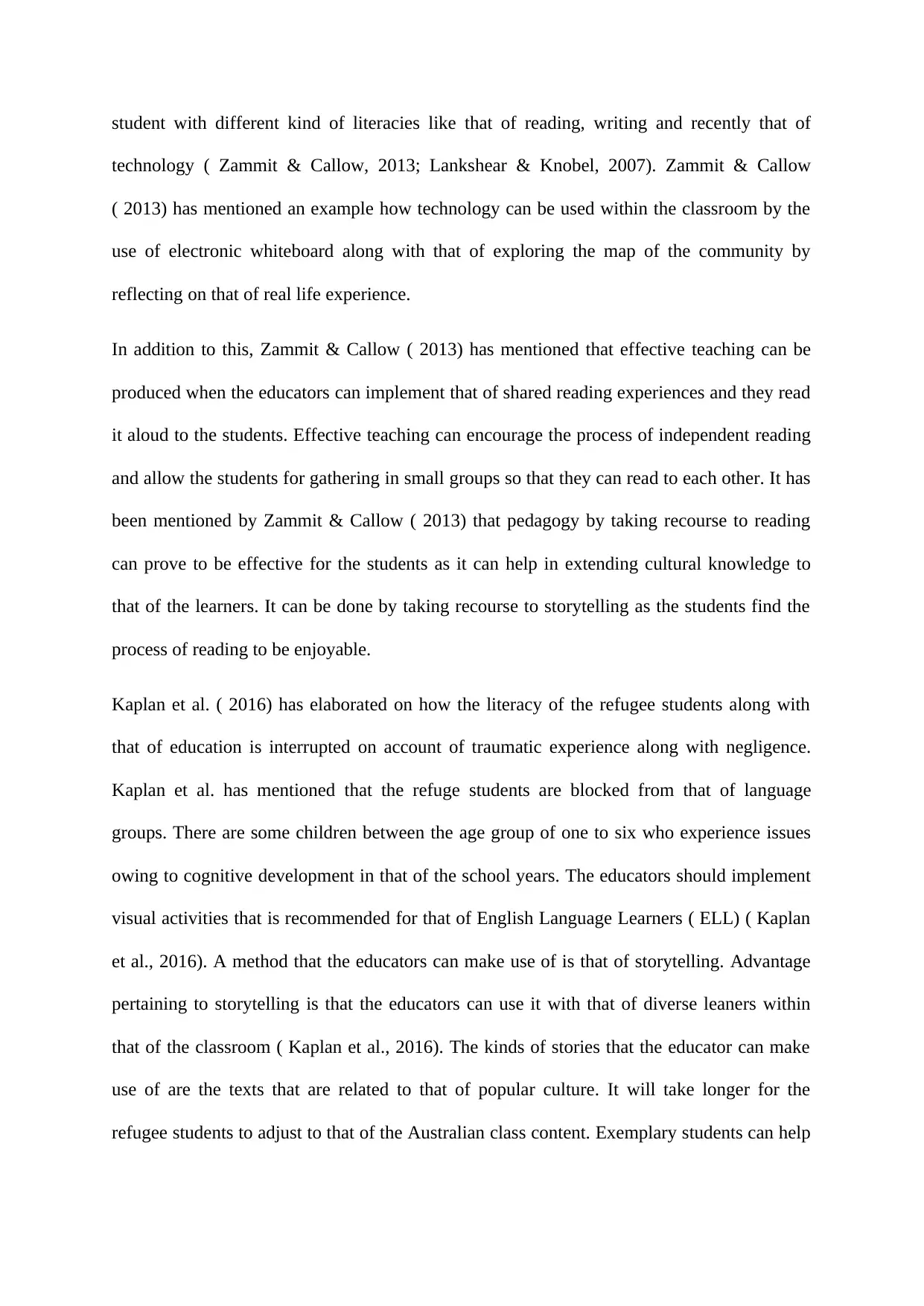
student with different kind of literacies like that of reading, writing and recently that of
technology ( Zammit & Callow, 2013; Lankshear & Knobel, 2007). Zammit & Callow
( 2013) has mentioned an example how technology can be used within the classroom by the
use of electronic whiteboard along with that of exploring the map of the community by
reflecting on that of real life experience.
In addition to this, Zammit & Callow ( 2013) has mentioned that effective teaching can be
produced when the educators can implement that of shared reading experiences and they read
it aloud to the students. Effective teaching can encourage the process of independent reading
and allow the students for gathering in small groups so that they can read to each other. It has
been mentioned by Zammit & Callow ( 2013) that pedagogy by taking recourse to reading
can prove to be effective for the students as it can help in extending cultural knowledge to
that of the learners. It can be done by taking recourse to storytelling as the students find the
process of reading to be enjoyable.
Kaplan et al. ( 2016) has elaborated on how the literacy of the refugee students along with
that of education is interrupted on account of traumatic experience along with negligence.
Kaplan et al. has mentioned that the refuge students are blocked from that of language
groups. There are some children between the age group of one to six who experience issues
owing to cognitive development in that of the school years. The educators should implement
visual activities that is recommended for that of English Language Learners ( ELL) ( Kaplan
et al., 2016). A method that the educators can make use of is that of storytelling. Advantage
pertaining to storytelling is that the educators can use it with that of diverse leaners within
that of the classroom ( Kaplan et al., 2016). The kinds of stories that the educator can make
use of are the texts that are related to that of popular culture. It will take longer for the
refugee students to adjust to that of the Australian class content. Exemplary students can help
technology ( Zammit & Callow, 2013; Lankshear & Knobel, 2007). Zammit & Callow
( 2013) has mentioned an example how technology can be used within the classroom by the
use of electronic whiteboard along with that of exploring the map of the community by
reflecting on that of real life experience.
In addition to this, Zammit & Callow ( 2013) has mentioned that effective teaching can be
produced when the educators can implement that of shared reading experiences and they read
it aloud to the students. Effective teaching can encourage the process of independent reading
and allow the students for gathering in small groups so that they can read to each other. It has
been mentioned by Zammit & Callow ( 2013) that pedagogy by taking recourse to reading
can prove to be effective for the students as it can help in extending cultural knowledge to
that of the learners. It can be done by taking recourse to storytelling as the students find the
process of reading to be enjoyable.
Kaplan et al. ( 2016) has elaborated on how the literacy of the refugee students along with
that of education is interrupted on account of traumatic experience along with negligence.
Kaplan et al. has mentioned that the refuge students are blocked from that of language
groups. There are some children between the age group of one to six who experience issues
owing to cognitive development in that of the school years. The educators should implement
visual activities that is recommended for that of English Language Learners ( ELL) ( Kaplan
et al., 2016). A method that the educators can make use of is that of storytelling. Advantage
pertaining to storytelling is that the educators can use it with that of diverse leaners within
that of the classroom ( Kaplan et al., 2016). The kinds of stories that the educator can make
use of are the texts that are related to that of popular culture. It will take longer for the
refugee students to adjust to that of the Australian class content. Exemplary students can help
Paraphrase This Document
Need a fresh take? Get an instant paraphrase of this document with our AI Paraphraser
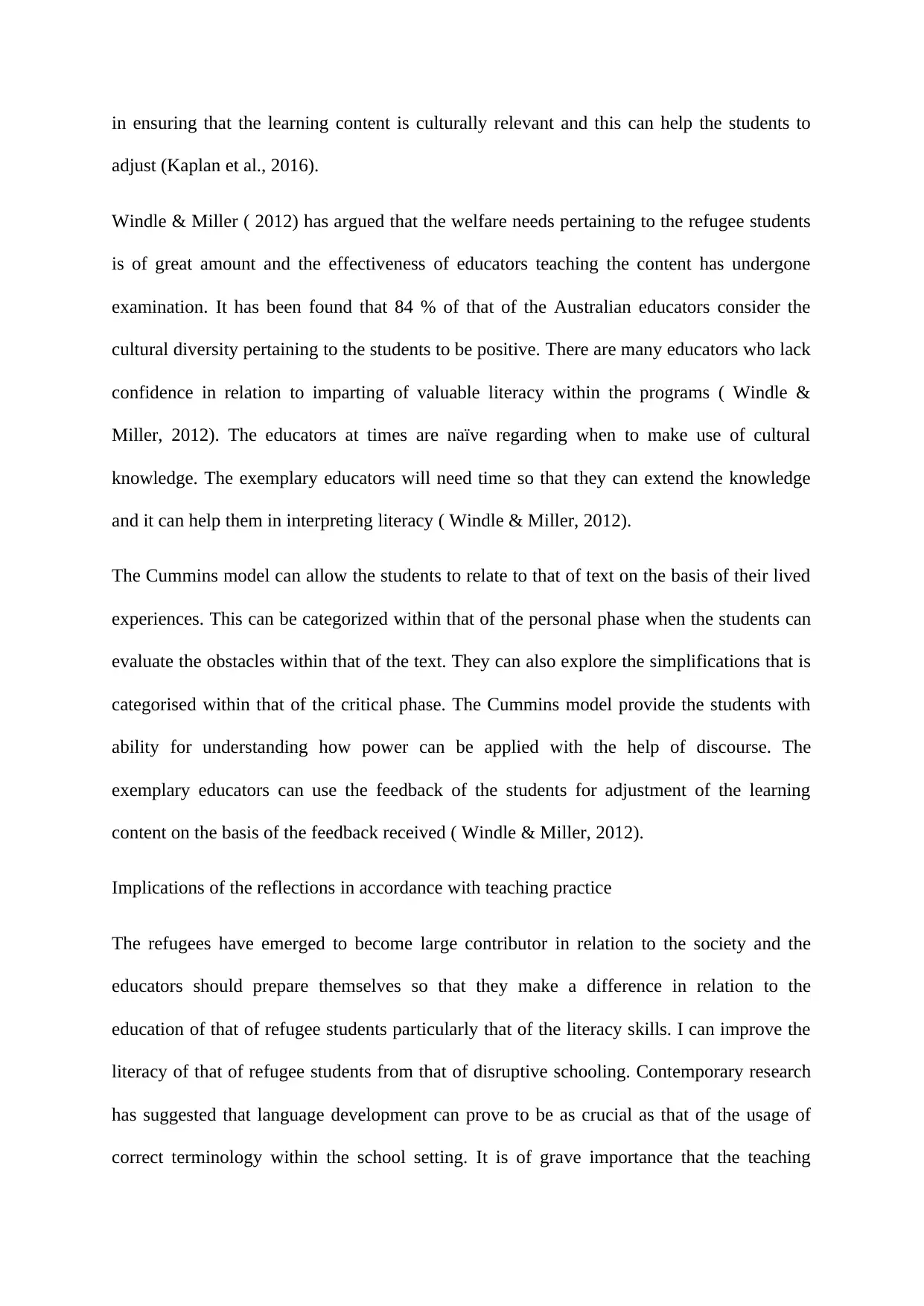
in ensuring that the learning content is culturally relevant and this can help the students to
adjust (Kaplan et al., 2016).
Windle & Miller ( 2012) has argued that the welfare needs pertaining to the refugee students
is of great amount and the effectiveness of educators teaching the content has undergone
examination. It has been found that 84 % of that of the Australian educators consider the
cultural diversity pertaining to the students to be positive. There are many educators who lack
confidence in relation to imparting of valuable literacy within the programs ( Windle &
Miller, 2012). The educators at times are naïve regarding when to make use of cultural
knowledge. The exemplary educators will need time so that they can extend the knowledge
and it can help them in interpreting literacy ( Windle & Miller, 2012).
The Cummins model can allow the students to relate to that of text on the basis of their lived
experiences. This can be categorized within that of the personal phase when the students can
evaluate the obstacles within that of the text. They can also explore the simplifications that is
categorised within that of the critical phase. The Cummins model provide the students with
ability for understanding how power can be applied with the help of discourse. The
exemplary educators can use the feedback of the students for adjustment of the learning
content on the basis of the feedback received ( Windle & Miller, 2012).
Implications of the reflections in accordance with teaching practice
The refugees have emerged to become large contributor in relation to the society and the
educators should prepare themselves so that they make a difference in relation to the
education of that of refugee students particularly that of the literacy skills. I can improve the
literacy of that of refugee students from that of disruptive schooling. Contemporary research
has suggested that language development can prove to be as crucial as that of the usage of
correct terminology within the school setting. It is of grave importance that the teaching
adjust (Kaplan et al., 2016).
Windle & Miller ( 2012) has argued that the welfare needs pertaining to the refugee students
is of great amount and the effectiveness of educators teaching the content has undergone
examination. It has been found that 84 % of that of the Australian educators consider the
cultural diversity pertaining to the students to be positive. There are many educators who lack
confidence in relation to imparting of valuable literacy within the programs ( Windle &
Miller, 2012). The educators at times are naïve regarding when to make use of cultural
knowledge. The exemplary educators will need time so that they can extend the knowledge
and it can help them in interpreting literacy ( Windle & Miller, 2012).
The Cummins model can allow the students to relate to that of text on the basis of their lived
experiences. This can be categorized within that of the personal phase when the students can
evaluate the obstacles within that of the text. They can also explore the simplifications that is
categorised within that of the critical phase. The Cummins model provide the students with
ability for understanding how power can be applied with the help of discourse. The
exemplary educators can use the feedback of the students for adjustment of the learning
content on the basis of the feedback received ( Windle & Miller, 2012).
Implications of the reflections in accordance with teaching practice
The refugees have emerged to become large contributor in relation to the society and the
educators should prepare themselves so that they make a difference in relation to the
education of that of refugee students particularly that of the literacy skills. I can improve the
literacy of that of refugee students from that of disruptive schooling. Contemporary research
has suggested that language development can prove to be as crucial as that of the usage of
correct terminology within the school setting. It is of grave importance that the teaching
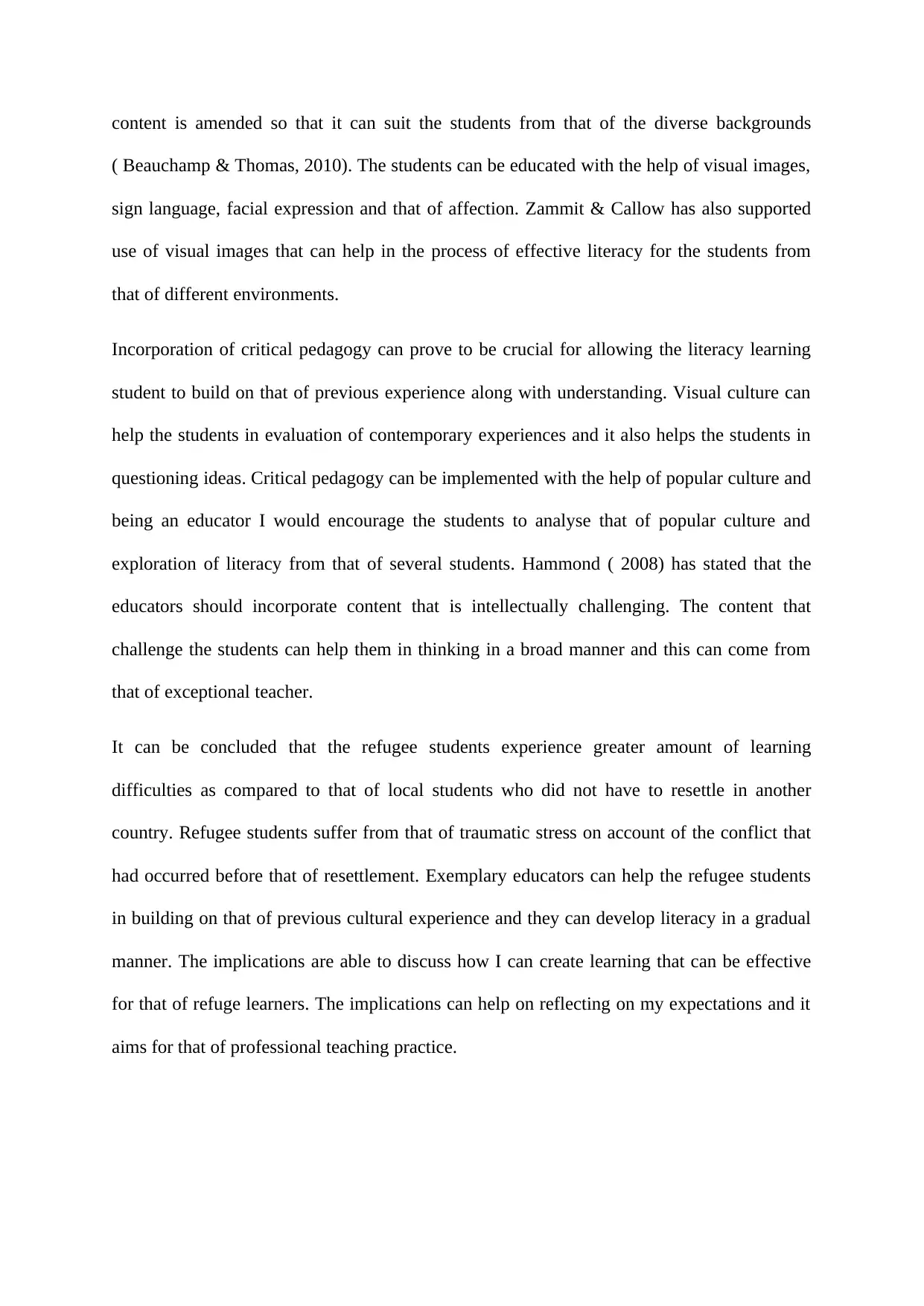
content is amended so that it can suit the students from that of the diverse backgrounds
( Beauchamp & Thomas, 2010). The students can be educated with the help of visual images,
sign language, facial expression and that of affection. Zammit & Callow has also supported
use of visual images that can help in the process of effective literacy for the students from
that of different environments.
Incorporation of critical pedagogy can prove to be crucial for allowing the literacy learning
student to build on that of previous experience along with understanding. Visual culture can
help the students in evaluation of contemporary experiences and it also helps the students in
questioning ideas. Critical pedagogy can be implemented with the help of popular culture and
being an educator I would encourage the students to analyse that of popular culture and
exploration of literacy from that of several students. Hammond ( 2008) has stated that the
educators should incorporate content that is intellectually challenging. The content that
challenge the students can help them in thinking in a broad manner and this can come from
that of exceptional teacher.
It can be concluded that the refugee students experience greater amount of learning
difficulties as compared to that of local students who did not have to resettle in another
country. Refugee students suffer from that of traumatic stress on account of the conflict that
had occurred before that of resettlement. Exemplary educators can help the refugee students
in building on that of previous cultural experience and they can develop literacy in a gradual
manner. The implications are able to discuss how I can create learning that can be effective
for that of refuge learners. The implications can help on reflecting on my expectations and it
aims for that of professional teaching practice.
( Beauchamp & Thomas, 2010). The students can be educated with the help of visual images,
sign language, facial expression and that of affection. Zammit & Callow has also supported
use of visual images that can help in the process of effective literacy for the students from
that of different environments.
Incorporation of critical pedagogy can prove to be crucial for allowing the literacy learning
student to build on that of previous experience along with understanding. Visual culture can
help the students in evaluation of contemporary experiences and it also helps the students in
questioning ideas. Critical pedagogy can be implemented with the help of popular culture and
being an educator I would encourage the students to analyse that of popular culture and
exploration of literacy from that of several students. Hammond ( 2008) has stated that the
educators should incorporate content that is intellectually challenging. The content that
challenge the students can help them in thinking in a broad manner and this can come from
that of exceptional teacher.
It can be concluded that the refugee students experience greater amount of learning
difficulties as compared to that of local students who did not have to resettle in another
country. Refugee students suffer from that of traumatic stress on account of the conflict that
had occurred before that of resettlement. Exemplary educators can help the refugee students
in building on that of previous cultural experience and they can develop literacy in a gradual
manner. The implications are able to discuss how I can create learning that can be effective
for that of refuge learners. The implications can help on reflecting on my expectations and it
aims for that of professional teaching practice.
⊘ This is a preview!⊘
Do you want full access?
Subscribe today to unlock all pages.

Trusted by 1+ million students worldwide
1 out of 6
Related Documents
Your All-in-One AI-Powered Toolkit for Academic Success.
+13062052269
info@desklib.com
Available 24*7 on WhatsApp / Email
![[object Object]](/_next/static/media/star-bottom.7253800d.svg)
Unlock your academic potential
Copyright © 2020–2025 A2Z Services. All Rights Reserved. Developed and managed by ZUCOL.





